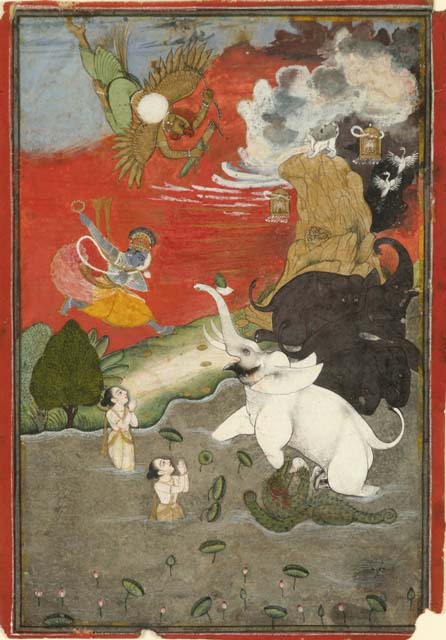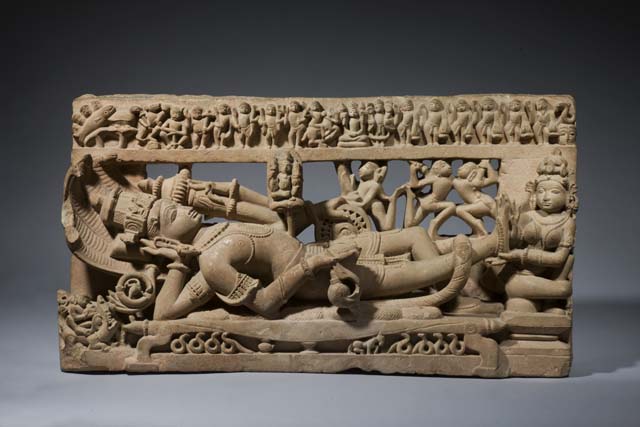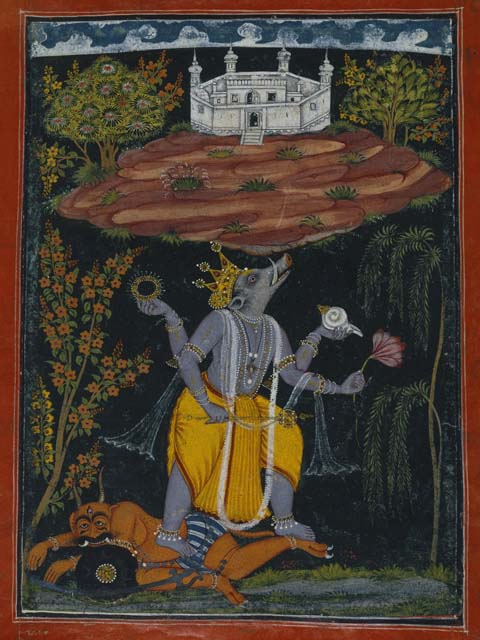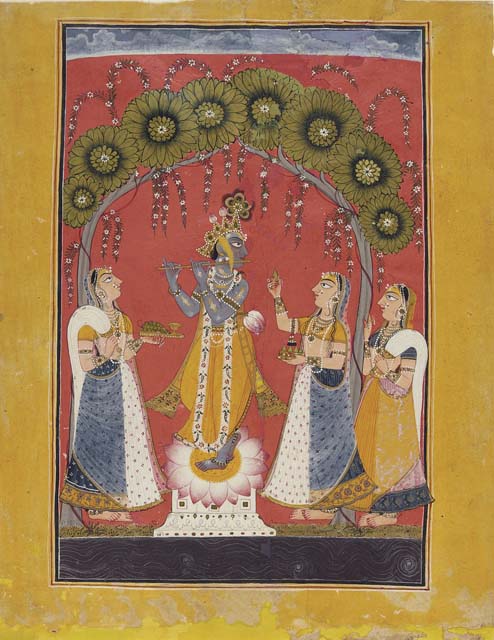
Vishnu Saving the Elephant (Gajendra Moksha), India, mid-18th century
Opaque watercolor and gold on paper
8 1/16 x 5 9/16 in. (20.5 x 14.1 cm)
Collection of Kenneth and Joyce Robbins
Vishnu, Hinduism’s Blue-Skinned Savior
Want to make some spiritual gains and rub shoulders with Gods and Goddesses? The place to go for darshan is the Brooklyn Museum because here you get to meet not one, not two but all ten avatars of Vishnu, Hinduism’s Blue-Skinned Savior.
“Vishnu – one of Hinduism’s most important and powerful deities – is the Great Preserver, vanquishing those who seek to destroy the balance of the universe,” writes Joan Cummins in ‘Vishnu – Hinduism’s Blue-Skinned Savior.’ Indeed, the time looks ripe for Vishnu’s avatar to come to earth…
Vishnu: Hinduism’s Blue-Skinned Savior has been organized by the Frist Center for the Visual Arts, Nashville, Tennessee, and curated by Cummins, who is the Lisa and Bernard Selz Curator of Asian Art at the Brooklyn Museum.

Vishnu in His Cosmic Sleep, India, circa 12th century
Sandstone
14 9/16 x 27 9/16 in. (37 x 70 cm). Private collection, Europe
Photo: Courtesy of Oliver Forge and Brendan Lynch Ltd.
On the day I made my pilgrimage to the Brooklyn Museum of Art, I jumped in on a tour of the exhibit being given by one of the docents. It was an all American group and it was clear to see they were fascinated by the richness of Hindu mythology and religion.
The gallery, opening into several rooms has been painted an intense purple, with lettering in orange and the large space is a celebration of Vishnu, with wonderful, rare artifacts and sculptures from across time and cultures, coming from India, Pakistan and Bangladesh.

Varaha Rescuing the Earth, Page from an illustrated Dashavatara series; India, circa 1730–40
Opaque watercolor, gold, and silver on paper
10 1/2 x 8 1/8 in. (26.7 x 20.6 cm)
Brooklyn Museum Collection
The Many Avatars of Vishnu
The treasures, including 16 from the museum’s permanent collection, are indeed an eyeful – from gorgeous Cholas sculptures including one of Krishna Dancing on Kaliya to a luminous watercolor on cloth of Vishnu Saving the Elephant (Gajendra Moksha). There is also a tiny gold crown for the image of a deity, probably Krishna, set with gemstones and pearls – just 5 X4 cm.! And yes, it all comes full circle to Bollywood film posters for movies like Balram Shri Krishna and Bajrangbali.
“In Hindu mythology Vishnu is first and foremost a savior, sweeping down from his lofty abode to bring peace and balance to a beleaguered earth,” writes Cummins in the accompanying catalogue. “Sometimes he remains in his heavenly form when saving the day: four-armed, holding a discus and a conch shell, and riding on his man-eagle, Garuda. But more often, he assumes an earthy form appropriate to the precise task at hand.”
In this fascinating exhibition, you get to see all ten avatars of Vishnu. There’s Matsya the fish, Kurma the tortoise, Varaha the boar, Narasimha the man-lion, Vamana the dwarf, Parashurama the Brahmin, Rama the prince, Krishna the cowherd-prince, the Buddha, and Kalki the avatar of the future.

By far the most popular avatar seems to be Krishna, the eight avatar of God Vishnu. One of the most beautiful pieces is a shrine for the worship of Krishna as an infant (Balakrishna) – Made in the Thanjavur region of Tamil Nadu in the 18th century this beautiful bejeweled water color enclosed by wooden doors. You see the plump baby Krishna enjoying butter balls.
As Cummins writes in ‘Vishnu: Hinduism’s Blue Skinned Savior’: “Krishna is the primary inspiration and focus for bhakti or religious devotion, in India. Because the god has an extensive earthly biography in which his personality emerges quite clearly, he is a more approachable, engaging form of the divine than most other Hindu deities.”
She adds, “Krishna’s followers envision strong, emotional relationships with the god, in the form of either an infant or a charismatic young man. Love – maternal or romantic – is used as a potent analogy for devotion to God, who is magnetic and delightful but also sometimes careless or naughty in his behavior.”
This large-scale exhibition includes Indian sculpture, paintings, textiles, and ritual objects that range in date from the fourth century C.E. to the twentieth century and can be seen till October 2, 2011 at the Brooklyn Museum.
Next page: Interview with Joan Cummins, Curator of South Asian Art, Brooklyn Museum
